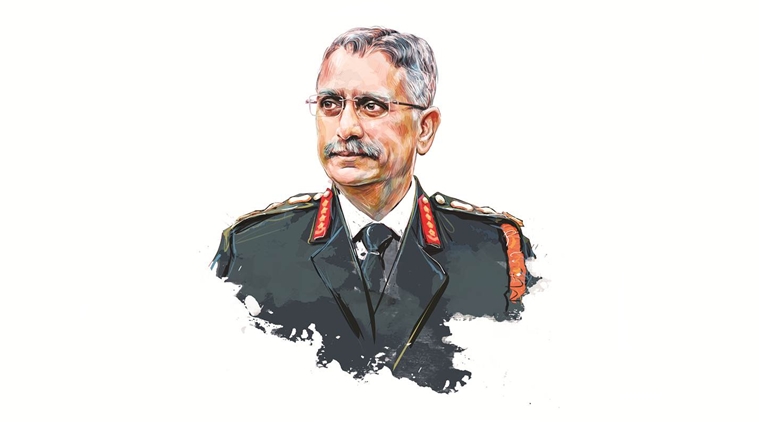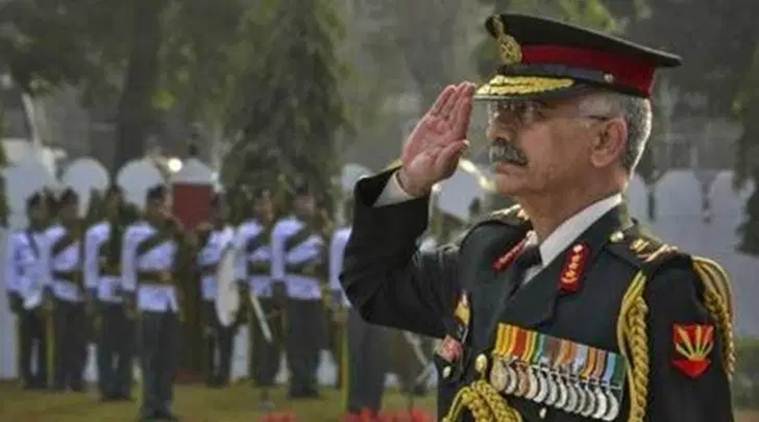A humble man who is direct and professional with colleagues and an officer who is known to deliver. Apart from his experience in counter-insurgency ops and the strike corps, these are qualities likely to hold General M M Naravane in good stead, as he takes over as Army Chief

General Naravane will serve as the head of the 1.3 million strong Army till he turns 62 in April 2022. (Illustration: Suvajit Dey)
As per tradition, on Independence Day, the General Officer Commanding (GOC), Delhi Area, a lieutenant general-rank officer, escorts the Prime Minister to the dais, stands behind him as he delivers his speech from the ramparts of Red Fort, and then escorts him back to his seat. In 2016, the then GOC, Delhi Area, Lt General Vijay Singh, followed the protocol. However, during Narendra Modi’s speech, he was asked to shift to the side so that he was not visible in the same frame as the Prime Minister.
The following year, there was a new GOC, Delhi Area. During Independence Day rehearsals, the Special Protection Group (SPG) once again raised the 2016 argument and objected to his presence behind the Prime Minister. This time, however, the new GOC did not stand behind Prime Minister Narendra Modi or shift to the side. After escorting Modi to the dais, he returned to his seat in the audience and after his speech ended, he got up to escort the Prime Minister back.
The officer was Lt General Manoj Mukund Naravane, who took over as the 28th Chief of Army Staff on the last day of the previous decade. General Naravane will serve as the head of the 1.3 million strong Army till he turns 62 in April 2022.
His colleagues say General Naravane’s ramrod straight posture and perfect military bearing is indicative of his conduct as a senior military officer: humble, fair, direct and professional. Whenever he was congratulated for his promotions, his reply, invariably, would be a laconic, “It is a part of the profession”.
 In his first media interaction as Army Chief on New Year’s morning, after inspecting the Guard of Honour, he revealed his regimental affiliations when he invoked ‘Waheguruji’ to give him “courage and strength” in his new role. (File)
In his first media interaction as Army Chief on New Year’s morning, after inspecting the Guard of Honour, he revealed his regimental affiliations when he invoked ‘Waheguruji’ to give him “courage and strength” in his new role. (File)
Born in 1960 in Pune to an Indian Air Force officer and an All India Radio announcer, he joined the National Defence Academy (NDA) at the age of 16 after his schooling from Jnana Prabodhini Prashala in the city. General Naravane’s childhood friends recall him as being very close to his parents. He came down to Pune a few months ago to celebrate his father’s birthday. His mother passed away in 2018.
Shimla-based writer-historian Raaja Bhasin, who got to know Naravane when he commanded the Army Training Command in Shimla, where he was also president of the Amateur Dramatics Club, says, “He is one of the most down-to-earth persons I have met. He is informal to the extent that when he came to meet us, he would ring the bell himself without any paraphernalia… We couldn’t stage a play for him but we did a rehearsed reading of Twelve Angry Men at his farewell.”
In 1976, General Naravane joined the NDA’s 56th course in Lima squadron, where the current IAF chief, Air Chief Marshal R K S Bhadauria, was his batchmate. The current Navy chief, Admiral Karambir Singh, was also part of the same batch, but in the Hunter squadron. To add to the string of coincidences, the fathers of all the three current service chiefs served in the IAF.
Later, in June 1980, after completing his training from the Indian Military Academy, he was commissioned in the seventh battalion of the Sikh Light Infantry. In his first media interaction as Army Chief on New Year’s morning, after inspecting the Guard of Honour, he revealed his regimental affiliations when he invoked ‘Waheguruji’ to give him “courage and strength” in his new role.
As a young officer, he served with the Indian Peace Keeping Force in Sri Lanka, one among his many stints in counter-insurgency operations — most notably in Jammu and Kashmir, where he commanded a Rashtriya Rifles battalion as a Colonel, and was Inspector General of the Assam Rifles in the Northeast. He also served as the country’s defence attaché to Myanmar. His path to the top was evident when he commanded the prestigious Strike Corps headquartered at Ambala and then headed the Eastern Command that’s tasked with securing the sensitive India-China border.
Though the present BJP government has come up with surprises in its selection of military chiefs, General Naravane was seen as the most likely candidate to succeed General Bipin Rawat after he moved to South Block as Vice Chief of Army Staff in September 2019. The official announcement of his elevation was made on December 16, an auspicious date for the Indian Army — it was on this date in 1971 that the Pakistan Army surrendered in Dhaka.
“General Manoj Naravane has served extensively in the mountains and in counter-insurgency environments. This, along with his exposure as Strike Corps Commander, would have truly empowered him to tackle the challenges that the Army faces today. A man of few words, he made his intent clear in his short media interaction shortly after taking over. His emphasis on reinforcing the core values of the Army, including its apolitical nature, was particularly welcome,” says Lt General A K Singh (retired), former Southern Army commander and former lieutenant governor of the Andaman & Nicobar Islands. “Also, as Army Chief, one of his first acts was to visit soldiers at the Base Hospital. That sends a good message to the rank and file.”
Speaking about his vision for the Army and the challenges ahead, the General said at the media interaction, “The priority will always remain to be ever-ready to meet any challenge and to be operationally prepared at all times. This will happen as a result of modernisation. We will continue to build up capabilities, especially in the North and Northeastern regions of the country. We will also lay emphasis on raising security awareness among the rank and file.”
Known to keep his family away from the limelight, Naravane is married to Veena Naravane, a teacher. They have two daughters, Isha, who is a performing artiste, and Amala, a PR consultant.
An M.Phil from Devi Ahilya Vishwavidyalaya, Indore, General Naravane is a keen reader of non-fiction. Not known to be fussy about food, he harbours a special interest for the state of Nagaland and is very fond of his Labrador.
